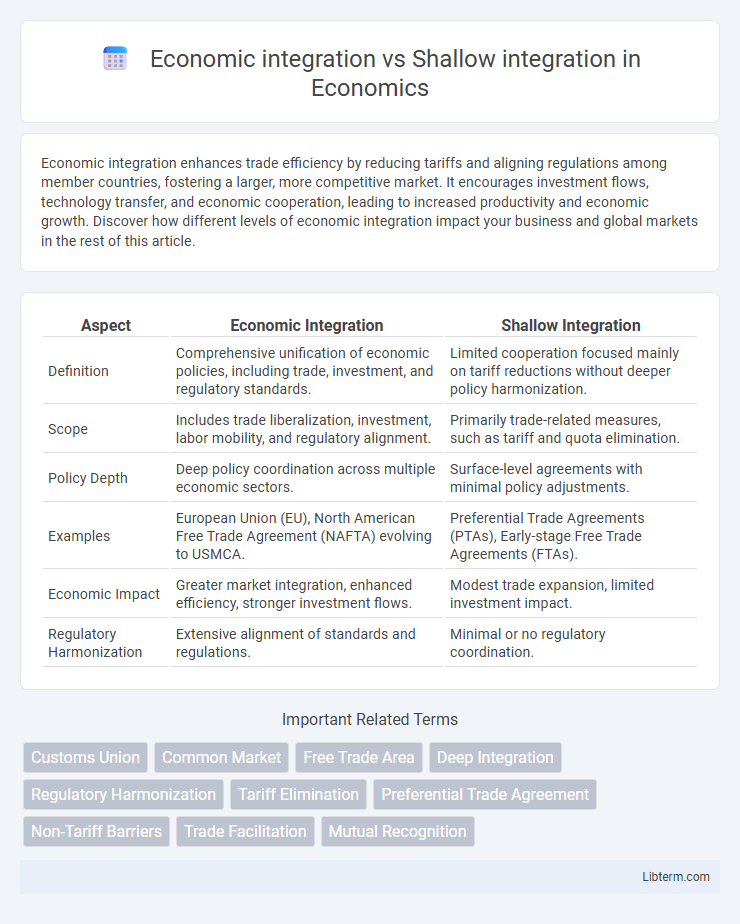Economic integration enhances trade efficiency by reducing tariffs and aligning regulations among member countries, fostering a larger, more competitive market. It encourages investment flows, technology transfer, and economic cooperation, leading to increased productivity and economic growth. Discover how different levels of economic integration impact your business and global markets in the rest of this article.
Table of Comparison
| Aspect | Economic Integration | Shallow Integration |
|---|---|---|
| Definition | Comprehensive unification of economic policies, including trade, investment, and regulatory standards. | Limited cooperation focused mainly on tariff reductions without deeper policy harmonization. |
| Scope | Includes trade liberalization, investment, labor mobility, and regulatory alignment. | Primarily trade-related measures, such as tariff and quota elimination. |
| Policy Depth | Deep policy coordination across multiple economic sectors. | Surface-level agreements with minimal policy adjustments. |
| Examples | European Union (EU), North American Free Trade Agreement (NAFTA) evolving to USMCA. | Preferential Trade Agreements (PTAs), Early-stage Free Trade Agreements (FTAs). |
| Economic Impact | Greater market integration, enhanced efficiency, stronger investment flows. | Modest trade expansion, limited investment impact. |
| Regulatory Harmonization | Extensive alignment of standards and regulations. | Minimal or no regulatory coordination. |
Introduction to Economic Integration
Economic integration refers to the process where countries reduce trade barriers to facilitate the free flow of goods, services, capital, and labor, aiming for deeper economic collaboration and increased market efficiency. Shallow integration involves the elimination of tariffs and quotas without significantly aligning regulatory standards or economic policies, resulting in limited harmonization between economies. Understanding the distinction highlights how economic integration often seeks comprehensive policy coordination beyond mere trade liberalization, promoting stronger interdependence among member states.
Defining Shallow Integration
Shallow integration refers to economic integration that primarily focuses on the reduction of tariffs and non-tariff barriers without deeply harmonizing regulations, standards, or policies between countries. It typically involves trade liberalization measures such as preferential tariff reductions and simple customs cooperation while allowing member states to maintain sovereign control over monetary, fiscal, and regulatory frameworks. This contrasts with deep economic integration, which aims for comprehensive policy alignment and institutional coordination beyond basic market access.
Key Features of Deep Economic Integration
Deep economic integration involves the elimination of non-tariff barriers, harmonization of regulatory standards, and the free movement of factors of production such as labor and capital across member countries. It goes beyond shallow integration, which typically focuses on tariff reductions and basic trade facilitation. Key features include coordinated fiscal policies, common competition rules, and alignment of intellectual property rights to create a seamless economic environment.
Types of Economic Integration Agreements
Economic integration encompasses various types of agreements ranging from shallow integration, like free trade areas and customs unions, focused primarily on reducing tariffs and quotas, to deeper integration forms such as common markets and economic unions that harmonize regulations and coordinate economic policies. Shallow integration agreements typically address trade liberalization without extensive policy alignment, while deeper integration involves comprehensive cooperation on factors like labor mobility, fiscal policy, and legal standards. Understanding these distinctions is crucial for analyzing the economic impact and policy commitments entailed in each type of integration agreement.
Benefits of Shallow Integration
Shallow integration enhances economic cooperation by focusing on the reduction of tariffs and non-tariff barriers, facilitating smoother trade flows and lowering costs for businesses. It promotes market access without requiring deep harmonization of regulations or economic policies, making it easier and faster for countries to implement. This approach benefits developing economies by improving export opportunities and attracting foreign investment without substantial sovereignty loss.
Advantages of Deep Economic Integration
Deep economic integration involves comprehensive removal of trade barriers, harmonization of regulations, and coordinated economic policies, which results in increased efficiency and economies of scale for member countries. This form of integration promotes higher levels of foreign direct investment, innovation, and technological transfer among participating nations. Enhanced market access and policy coordination reduce transaction costs and create a stable environment for sustainable economic growth.
Challenges and Risks of Shallow Integration
Shallow integration primarily involves reducing tariffs and non-tariff barriers without harmonizing regulatory standards, leading to significant challenges such as regulatory divergences and limited policy coordination. This lack of deeper institutional alignment increases risks like trade diversion, inconsistent enforcement of rules, and vulnerability to external economic shocks. Consequently, shallow integration often results in less efficient market outcomes compared to deeper economic integration frameworks that emphasize comprehensive policy and institutional convergence.
Case Studies: Shallow vs Deep Integration
Economic integration involves the unification of markets through various levels of policy alignment, whereas shallow integration focuses primarily on reducing tariffs and non-tariff barriers without harmonizing deeper regulatory frameworks. Case studies such as the North American Free Trade Agreement (NAFTA) demonstrate shallow integration by emphasizing tariff elimination, while the European Union exemplifies deep integration by fostering not only free trade but also regulatory convergence, common standards, and labor mobility. Comparative analyses reveal that deep integration tends to generate more substantial economic benefits by addressing behind-the-border issues, enhancing investment flows, and strengthening institutional cooperation.
Impact on Trade and Investment Flows
Economic integration deepens trade and investment flows by removing tariffs, harmonizing regulations, and facilitating capital mobility, resulting in increased cross-border transactions and supply chain efficiency. Shallow integration, focusing mainly on tariff reductions without addressing non-tariff barriers or regulatory convergence, leads to modest improvements in trade volume but limited growth in foreign direct investment (FDI). Empirical data shows that comprehensive economic integration regimes like customs unions and common markets significantly outperform free trade agreements in boosting bilateral trade and attracting multinational enterprises.
Future Trends in Economic Integration
Economic integration continues to evolve with future trends emphasizing deeper collaboration beyond traditional shallow integration, which mainly involves tariff reductions and trade facilitation. Emerging frameworks prioritize harmonization of regulations, digital trade, and sustainable development goals to create more resilient and inclusive markets. Technological advancements and geopolitical shifts are driving efforts towards comprehensive integration, encompassing investment, labor mobility, and innovation ecosystems.
Economic integration Infographic

 libterm.com
libterm.com